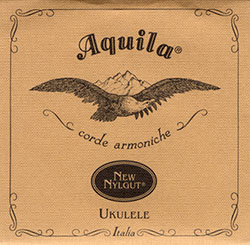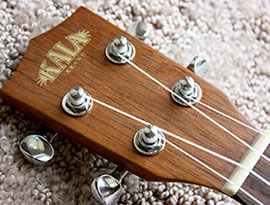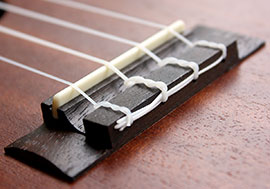How to String a Ukulele
While ukulele strings are usually made out of nylon, which breaks much less commonly than metal, it is still quite likely that at some stage you will need to restring your uke. Whether your string has broken, been worn down, or you simply would like to try out some new strings, you will need to learn how to remove your old strings and fit a new ones properly. While it can seem like a daunting task the first time you try to restring a string on your ukulele, once you know what to do and have tried it out a couple of times it will be a relatively painless experience!
What Ukulele Strings You Should Use

Buy strings that suit your level. There is not much point for a beginner to play on expensive strings, but at the same time, you will not get the same sweetness of sound or tone using poor-quality strings. This doesn't matter so much with nylon strings, but it does make quite a considerable difference with metal ones.
You get what you pay for. Cheap strings will break more easily than more expensive strings, and they can also stretch unreliably and/or start to unravel (in the case of metal strings) soon after stringing.
Make sure you get the right kind of strings for your ukulele. Know what type of ukulele you have: soprano, concert, tenor, or baritone and buy strings that are specifically made for that type of ukulele. Check with your local music store if you are unsure about what kind of strings you need.
Aquila strings are the most popular, however it is important to research and find out what strings you prefer most. Here are is a list of Ukulele Strings you can buy.
When Should You Change Your Ukulele Strings
You should change out your strings when they lose their playability and tone. Signs that show your in need of new strings are:
There are grooves, nicks, or flat spots on the strings.
Tone sounds dull and they are not as resonant as one you first put them on.
After the initial breaking in they have trouble staying in tune.
Nylon ukulele strings are rather durable and are less susceptible to damage from oils and sweat than metal wound strings which are often found on guitars. How often you need to change your strings depends on how much you play it. This could be every other month to about every six months.
Restring your strings, if they need it, well before performances as the string will stretch considerably when your uke is first strung.
How to Restring a Ukulele
Whether your ukulele has metal or nylon strings, it does pay to get into good restringing habits. As such, it is advisable to make sure that you direct the headstock away from your person, as you don't want to be in the direct line of fire if one of your strings happens to break! You may also want to wear eye protection, just in case.
There are a lot of different types of ukulele out there! Some have tuning pegs to the side, like on a guitar, while others have the tuning pegs facing backwards. Some have standard bridges, while others have tie-bar bridges. Baritone ukuleles often have a mixture of wound (metal) and nylon strings, and tenor ukuleles may also have one or two wound strings. Keep this in mind as you may need to amend our restringing guide to suit your ukulele - if you get stuck, leave a comment below.
To Restring Your Ukulele You Will Need:
- A new string (or set of strings) to replace the old one(s).
- A pair of wire cutters, sharp scissors or string cutters.
- A rubbish bin nearby, to put string offcuts in once you are done with them.
- A string winder (optional).
- A clear, flat working surface or table. Somewhere you can safely put your ukulele down, and rest your ukulele on when tightening the strings if needed. Make sure there is nothing around that might damage or scratch your instrument.
Tips Before You Restring
Only restring strings one at a time! This means you will never get muddled as to what string goes on which machine head or peg, and as an added bonus you will have other strings to look at to guide your own stringing.
If you are replacing all of your ukulele strings, start with the C string first and then string the E string, A string and finally the G string. Higher strings can feel more intimidating to tune as they are thinner, and you are more likely to break them accidentally (although this isn't as much of a problem if you have nylon strings).
Restringing Steps
-
Loosen the string until it slides easily off the tuning peg. If you are unsure which direction to turn the peg, pluck the string while turning the peg in one direction. If the pitch goes down, you are doing it right. If the pitch rises, simply switch the direction you are turning. Remove the string from the tuning peg when it is loose enough. If you have a slotted head ukulele then you will need to unwind the string enough to be able to push the string through the hole. Alternatively, you may want to unwind the string until it is slack and then cut the string with your scissors or wire cutters, and then remove the top part of the string from the headstock.
Tip: To make winding faster, you might like to consider purchasing a string winder. These are relatively cheap, and very easy to use! -
Carefully remove the string out from the bridge. What method you use will depend on what type of bridge you have.
Standard Bridge: Your string has a knot on the end that holds it in place at the bridge. In this case, your string needs to be slid off, parallel to the body of the ukulele. Sometimes the string can get wedged in quite tightly, so it may take some time and patience to coax the string out. Be careful that you don't damage the bridge with vigorous tugging at the string. Never pull up on the string to free it from the bridge!
Tie-Bar Bridge: Your string is tied to the bridge, as the name suggests. You will need to carefully untie the string from the bridge, pushing the free end of the string into the knot until it loosens enough for you to untie it completely. The knots may be quite tight, and it may require persistent effort to loosen the knots.
-
Now that your old string is detached from your ukulele and discarded, you are ready to string your new string.
Standard Bridge: To attach a string when your ukulele has a standard bridge, first tie a knot in one end of the string, leaving a tail about an inch long. Tie another knot in the string, at the same point as the first knot, preferably reversing the second knot (so that the knots oppose each other) Slip the double-knot you have made into the notch at the bridge, where your old string was attached. Make sure the string is sitting comfortably in the notch by pulling the string towards the headstock of the ukulele. Pull the string so you create a significant amount of tension, to check that the double-knot will hold. Once you have checked that the knot will hold, you can take the string back out of the notch and trim off the excess string below the knot, leaving 5mm or so under the knot in case it slips a little. Then put the string back in the notch.
Tie-Bar Bridge: Slide one end of the string into the small hole at the bridge, inserting the string so that the end comes out the bottom (the side opposite the sound hole). Slide the string through the hole until you have about an inch and a half of length coming out the end. Take the end of the string that you have threaded through and loop up and behind the string at the top. Then, loop the end of the string under the length of string that runs over the bridge at least twice (preferably three times) before pulling the end of the string out the bottom so that the loops tighten.
-
Now that the string is fastened at the bridge, you can continue to fasten the string at the headstock of the ukulele. Slip the other end of the string through the metal hole in the tuning peg or slot, pulling most of the excess string through the hole. Pull the string taught, and begin tightening it with the tuning peg. It can help to press the string down with your finger in the space between nut and the tuning peg, so that the string winds on down towards the bottom of the peg.
-
Snip off the excess ends at the top of the string by the headstock with your wire cutters or scissors. For ukuleles with the tie-bar bridge, you can now also snip the excess off at the bridge too.
-
Now that your new strings are on your ukulele, you can proceed to tuning your ukulele using our Online Ukulele Tuner. Be sure to note that your strings will continue to stretch out over the next few times you play. You can hurry this process along by stretching your strings away from the ukulele (placing a finger under the string and pulling up slowly) and then re-tuning. Although, of course, the best way to stretch out those strings is by playing them!














Have dusted off my uke and realised that the reason it was gathering dust was because it was a bit broken.So fixed it, but forgot how the stringy thing went. Thanks for your very clear and direct info. This one's for you.
Think my Tenor is a String through bridge..how would I do that ?
THanks - good picture. Exactly what I was looking for to restring my tenor - I previously replaced the original (high) G string with a low-G e I estimated as the diameter needed - not a good result as it was always out of tune (sharp) going up the fretboard. The new set sounds so much better, especially the G (low). I was able to make the final result "tidy" as shown in your picture. Thanks again!
trying to sting my new-- used uke , I bought color coded stings and have no idea which one goes where. please help! cant try to play with no strings. thank you, Lilli
So helpful!!
Thank you! I was worried about restringing my uke, but your guide made it super easy!
What order do I put the strings in? The new strings are color-coded but I don't know what order to put them on the ukulele.
I'm confused
BillyVam
wh0cd268445 [url=http://femaleviagra.us.org/]sildenafil citrate women[/url]
BOUGHT A UKELELE MAHALA WITH 4 NYLON STRINGS ON ,TUNED gcea FIRST STRING NEAREST FLOOR ,THIN .6 MM,2ND & 3RD APPROX .9MM AND 4TH TOP WHEN YOU HOLD IT IN PLAYING POSITION .6MM ,IS THIS THE RIGHT WAY THEY GO.iS IT A TENOR, BARITONE OR SOPRANA .HOW DO i TELL. i COME FROM GUITARS,MANDOLINS, & AND BASS GUITARS. tHIS UKELELE IS FOR SOMEONE ELSE. MANY THANKS sTAN 9 AUG.2017
I just got my ukulele, and already I've managed to pop a string while tuning it. Your guide was helpful, and now it sounds as good as ever! Thank you for your help.
I just got my ukulele, and already I've managed to pop a string while tuning it. Your guide was helpful, and now it sounds as good as ever! Thank you for your help.
I noticed a couple of comments that weren't as positive as they should be so felt compelled to write and thank you so much. Just restrung my soprano and this guide was so useful. Only been playing a couple of months and now the sound is great ðŸ‘🻠very grateful for your tips 😀
I did a minor repair to a uke belonging to a friend and got all four strings mixed .I am not familiar with a kid although I play guitar . It has a set of four nylon strings and it is only a very in-expensive use. The strings seem to be four different sizes in diameter. Which order should I put them back?
AWESOME!FOLLOWING YOUR INSTRUCTIONS MADE IT MUCH LESS INTIMIDATING THAN I EXPECTED IT TO BE. MY UKE IS SOUNDING GREAT...MAHALO!
Strings always unravel
I HAVE DONE EVERTHING AND MY STRINGS ALWAYS UNRAVEL AT THE TIEBLOCK!!! SOMEONE HELP!
Ukulelebuzz choose the best ukulele for beginners
Donald Stephen thanks for sharing my http://www.ukulelebuzz.com/
Best ukulele strings
A good strings made good sound so when you will buy an ukulele that time you also know about strings also . try to buy good strings not cheap rate strings because cheap rate strings is not good . to know more about ukulele strings visit here >>> www.ukulelebuzz.com
Bad
This is bad
Bad
This is bad
not quite precise enough
The trick to tying onto a tie bridge is this- DON'T wrap the string around itself as you go up, away from the bridge towards the sound hole. DO THIS- put the string through the bridge, leaving most of the string length going towards the sound hole and neck. Leave about 1.5 - 2 inches hanging out the bottom of the ukulele. Take that short end up over the bridge and bring it around itself. Now, make 3-4 wraps around itself GOING BACK TOWARDS THE BRIDGE. Pull it tight and to with tying it to the tuner. If you wrap going up, away from the bridge, you'll get a messy knot, or just a mess that won't hold at all.